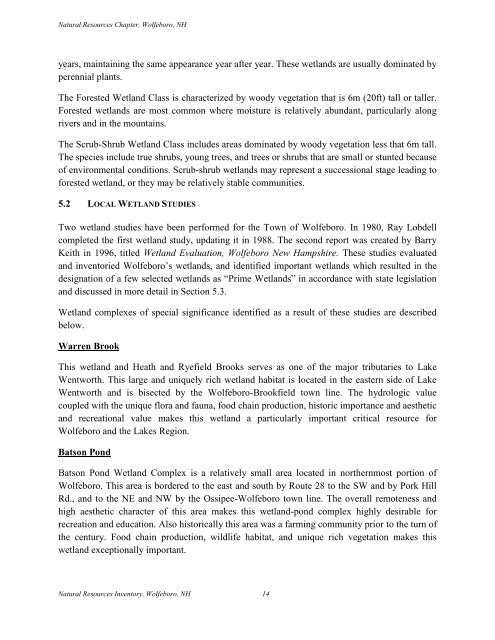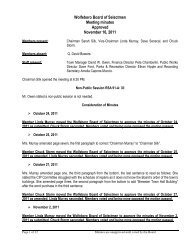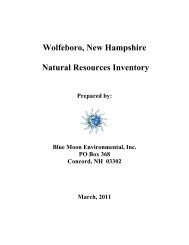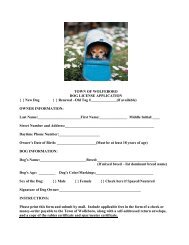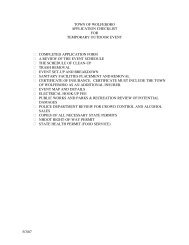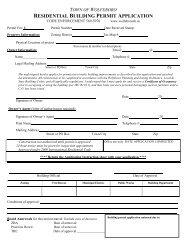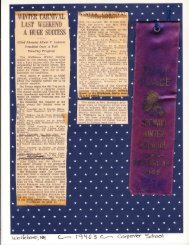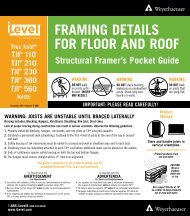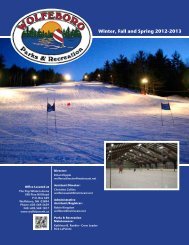Natural Resources Chapter of the Master Plan - Town of Wolfeboro
Natural Resources Chapter of the Master Plan - Town of Wolfeboro
Natural Resources Chapter of the Master Plan - Town of Wolfeboro
You also want an ePaper? Increase the reach of your titles
YUMPU automatically turns print PDFs into web optimized ePapers that Google loves.
<strong>Natural</strong> <strong>Resources</strong> <strong>Chapter</strong>, <strong>Wolfeboro</strong>, NH<br />
years, maintaining <strong>the</strong> same appearance year after year. These wetlands are usually dominated by<br />
perennial plants.<br />
The Forested Wetland Class is characterized by woody vegetation that is 6m (20ft) tall or taller.<br />
Forested wetlands are most common where moisture is relatively abundant, particularly along<br />
rivers and in <strong>the</strong> mountains.<br />
The Scrub-Shrub Wetland Class includes areas dominated by woody vegetation less that 6m tall.<br />
The species include true shrubs, young trees, and trees or shrubs that are small or stunted because<br />
<strong>of</strong> environmental conditions. Scrub-shrub wetlands may represent a successional stage leading to<br />
forested wetland, or <strong>the</strong>y may be relatively stable communities.<br />
5.2 LOCAL WETLAND STUDIES<br />
Two wetland studies have been performed for <strong>the</strong> <strong>Town</strong> <strong>of</strong> <strong>Wolfeboro</strong>. In 1980, Ray Lobdell<br />
completed <strong>the</strong> first wetland study, updating it in 1988. The second report was created by Barry<br />
Keith in 1996, titled Wetland Evaluation, <strong>Wolfeboro</strong> New Hampshire. These studies evaluated<br />
and inventoried <strong>Wolfeboro</strong>‟s wetlands, and identified important wetlands which resulted in <strong>the</strong><br />
designation <strong>of</strong> a few selected wetlands as “Prime Wetlands” in accordance with state legislation<br />
and discussed in more detail in Section 5.3.<br />
Wetland complexes <strong>of</strong> special significance identified as a result <strong>of</strong> <strong>the</strong>se studies are described<br />
below.<br />
Warren Brook<br />
This wetland and Heath and Ryefield Brooks serves as one <strong>of</strong> <strong>the</strong> major tributaries to Lake<br />
Wentworth. This large and uniquely rich wetland habitat is located in <strong>the</strong> eastern side <strong>of</strong> Lake<br />
Wentworth and is bisected by <strong>the</strong> <strong>Wolfeboro</strong>-Brookfield town line. The hydrologic value<br />
coupled with <strong>the</strong> unique flora and fauna, food chain production, historic importance and aes<strong>the</strong>tic<br />
and recreational value makes this wetland a particularly important critical resource for<br />
<strong>Wolfeboro</strong> and <strong>the</strong> Lakes Region.<br />
Batson Pond<br />
Batson Pond Wetland Complex is a relatively small area located in nor<strong>the</strong>rnmost portion <strong>of</strong><br />
<strong>Wolfeboro</strong>. This area is bordered to <strong>the</strong> east and south by Route 28 to <strong>the</strong> SW and by Pork Hill<br />
Rd., and to <strong>the</strong> NE and NW by <strong>the</strong> Ossipee-<strong>Wolfeboro</strong> town line. The overall remoteness and<br />
high aes<strong>the</strong>tic character <strong>of</strong> this area makes this wetland-pond complex highly desirable for<br />
recreation and education. Also historically this area was a farming community prior to <strong>the</strong> turn <strong>of</strong><br />
<strong>the</strong> century. Food chain production, wildlife habitat, and unique rich vegetation makes this<br />
wetland exceptionally important.<br />
<strong>Natural</strong> <strong>Resources</strong> Inventory, <strong>Wolfeboro</strong>, NH 14


